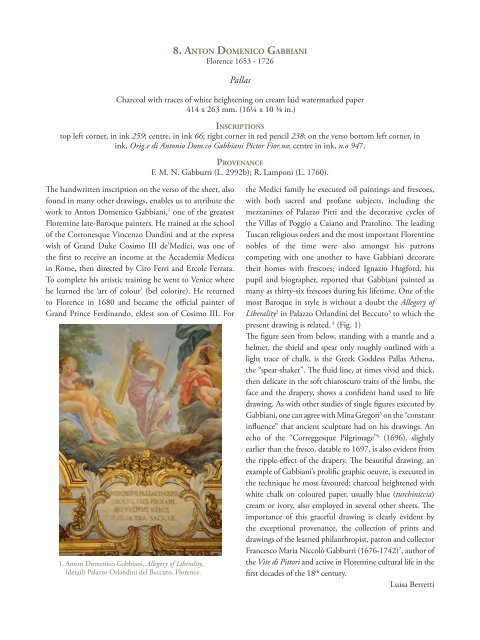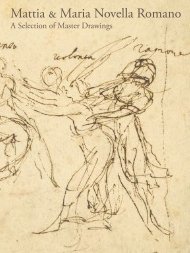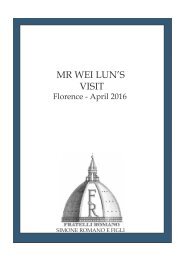A Selection of master drawings 2014
- No tags were found...
You also want an ePaper? Increase the reach of your titles
YUMPU automatically turns print PDFs into web optimized ePapers that Google loves.
8. Anton Domenico Gabbiani<br />
Florence 1653 - 1726<br />
Pallas<br />
Charcoal with traces <strong>of</strong> white heightening on cream laid watermarked paper<br />
414 x 263 mm. (16¼ x 10 ⅜ in.)<br />
Inscriptions<br />
top left corner, in ink 259; centre, in ink 66; right corner in red pencil 238; on the verso bottom left corner, in<br />
ink, Orig.e di Antonio Dom.co Gabbiani Pictor Fior.no; centre in ink, n.o 947.<br />
Provenance<br />
F. M. N. Gabburri (L. 2992b); R. Lamponi (L. 1760).<br />
The handwritten inscription on the verso <strong>of</strong> the sheet, also<br />
found in many other <strong>drawings</strong>, enables us to attribute the<br />
work to Anton Domenico Gabbiani, 1 one <strong>of</strong> the greatest<br />
Florentine late-Baroque painters. He trained at the school<br />
<strong>of</strong> the Cortonesque Vincenzo Dandini and at the express<br />
wish <strong>of</strong> Grand Duke Cosimo III de’Medici, was one <strong>of</strong><br />
the first to receive an income at the Accademia Medicea<br />
in Rome, then directed by Ciro Ferri and Ercole Ferrata.<br />
To complete his artistic training he went to Venice where<br />
he learned the ‘art <strong>of</strong> colour’ (bel colorire). He returned<br />
to Florence in 1680 and became the <strong>of</strong>ficial painter <strong>of</strong><br />
Grand Prince Ferdinando, eldest son <strong>of</strong> Cosimo III. For<br />
1. Anton Domenico Gabbiani, Allegory <strong>of</strong> Liberality,<br />
(detail) Palazzo Orlandini del Beccuto, Florence.<br />
the Medici family he executed oil paintings and frescoes,<br />
with both sacred and pr<strong>of</strong>ane subjects, including the<br />
mezzanines <strong>of</strong> Palazzo Pitti and the decorative cycles <strong>of</strong><br />
the Villas <strong>of</strong> Poggio a Caiano and Pratolino. The leading<br />
Tuscan religious orders and the most important Florentine<br />
nobles <strong>of</strong> the time were also amongst his patrons<br />
competing with one another to have Gabbiani decorate<br />
their homes with frescoes; indeed Ignazio Hugford, his<br />
pupil and biographer, reported that Gabbiani painted as<br />
many as thirty-six frescoes during his lifetime. One <strong>of</strong> the<br />
most Baroque in style is without a doubt the Allegory <strong>of</strong><br />
Liberality 2 in Palazzo Orlandini del Beccuto 3 to which the<br />
present drawing is related. 4 (Fig. 1)<br />
The figure seen from below, standing with a mantle and a<br />
helmet, the shield and spear only roughly outlined with a<br />
light trace <strong>of</strong> chalk, is the Greek Goddess Pallas Athena,<br />
the “spear-shaker”. The fluid line, at times vivid and thick,<br />
then delicate in the s<strong>of</strong>t chiaroscuro traits <strong>of</strong> the limbs, the<br />
face and the drapery, shows a confident hand used to life<br />
drawing. As with other studies <strong>of</strong> single figures executed by<br />
Gabbiani, one can agree with Mina Gregori 5 on the “constant<br />
influence” that ancient sculpture had on his <strong>drawings</strong>. An<br />
echo <strong>of</strong> the “Correggesque Pilgrimage” 6 (1696), slightly<br />
earlier than the fresco, datable to 1697, is also evident from<br />
the ripple-effect <strong>of</strong> the drapery. The beautiful drawing, an<br />
example <strong>of</strong> Gabbiani’s prolific graphic oeuvre, is executed in<br />
the technique he most favoured: charcoal heightened with<br />
white chalk on coloured paper, usually blue (turchiniccia)<br />
cream or ivory, also employed in several other sheets. The<br />
importance <strong>of</strong> this graceful drawing is clearly evident by<br />
the exceptional provenance, the collection <strong>of</strong> prints and<br />
<strong>drawings</strong> <strong>of</strong> the learned philanthropist, patron and collector<br />
Francesco Maria Niccolò Gabburri (1676-1742) 7 , author <strong>of</strong><br />
the Vite di Pittori and active in Florentine cultural life in the<br />
first decades <strong>of</strong> the 18 th century.<br />
Luisa Berretti





